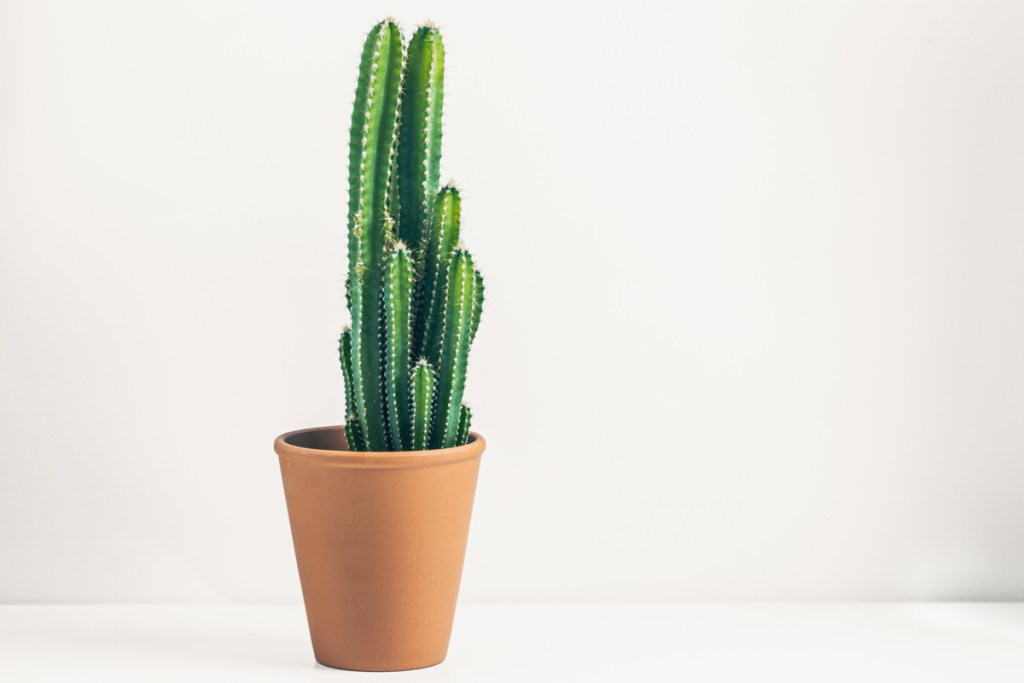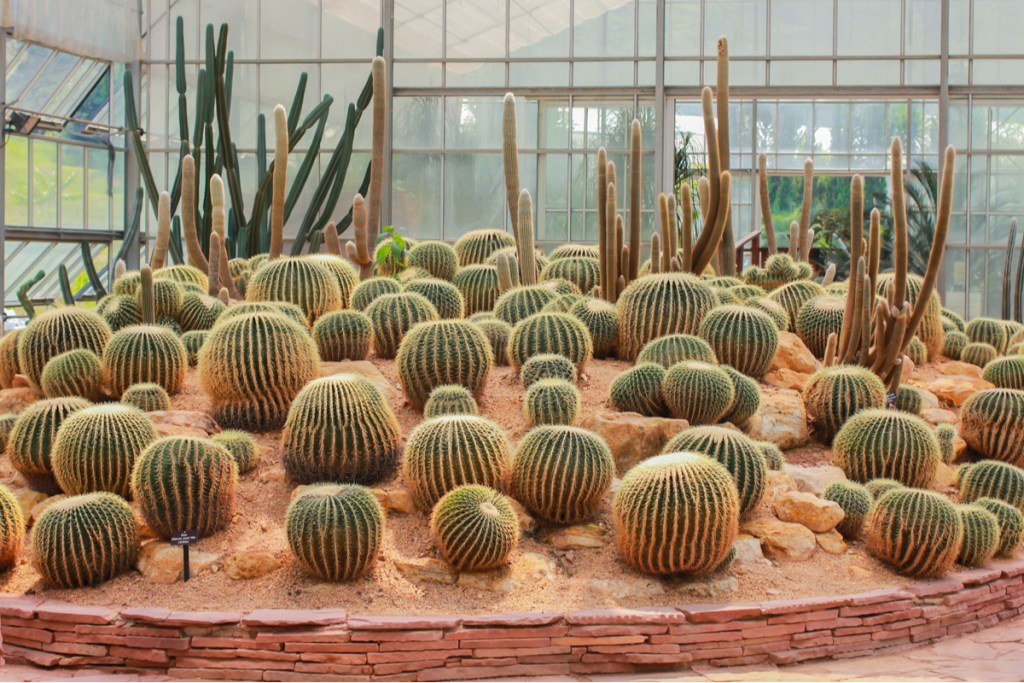Houseplants bring a lot of benefits into your home, small and large ones alike. Each size plant has its own place, be it on a table, a shelf, in a hanging basket, or on the floor. When people think of large houseplants, though, a cactus isn’t always the first choice. They’re pointy, difficult to handle, and can pose a risk to any kids or pets in the home. But if you don’t have any dependents to worry about, they can actually be a gorgeous investment.
Large cacti are as unique as their smaller counterparts, and because a lot of them are slow-growers, having one reach a substantial size can feel pretty rewarding. Not every cactus can grow big and tall, though; here are some of our favorites.

Mexican fence post cactus (Pachycereus marginatus)
The Mexican fence post cactus (Pachycereus marginatus) is a dark green columnar variety that has defined ribs and white spines. They’re native to Mexico and the southern US, preferring temperatures between 70 and 80 degrees Fahrenheit to thrive. When well cared for, they grow bell-shaped blooms in the springtime that range from pink to red.
Considering the conditions in its native habitat, the Mexican fence post cactus doesn’t do well in temperatures that are consistently below 50 degrees Fahrenheit — which makes it a perfect candidate for your indoor garden! Even if you keep your home at 65 to 69 degrees during the winter, the Mexican fence post cactus will be able to survive. If you have an outdoor space, you can always transition it to a patio or balcony for the summer months, bringing it in again in the fall. Take care to never let it get exposed to frost.
Light needs: At least six hours of direct sunlight per day
Water needs: Soak and dry method, watering only when soil is completely dry
Soil needs: Well-draining, cactus-specific potting mix
Blue myrtle cactus (Myrtillocactus geometrizans)
The blue myrtle cactus (Myrtillocactus geometrizans) is another large cactus variety that’s great for growing in homes. It can be propagated with cuttings, so if you find yourself wanting more than one, they’re easy to get! The blue myrtle cactus is fast-growing, getting to a mature size of 16 feet when grown outdoors. Its stems are (unsurprisingly) blue-green to blue-gray in color with anywhere from five to eight defined ribs. This species branches when it reaches maturity, adding a bit of depth and uniqueness to its appearance.
When grown indoors, it can still grow to a decent size; however, you can control its size and shape with yearly pruning of stems. Whether you prune or not, you won’t have to worry about the plant growing to its outdoor size and spreading across your ceiling. If you still want it to grow strong and healthy, make sure that your blue myrtle cactus has well-draining soil and a pot where excess water has a place to go, be it a drip tray or a layer of pebbles.
Light needs: At least six hours of full sun per day
Water needs: Soak and dry method, watering only when soil is completely dry
Soil needs: Well-draining, cactus-specific potting mix
Blue columnar cactus (Pilosocereus pachycladus)
The blue columnar cactus (Pilosocereus pachycladus) is another stunning, fast-growing variety that can grow between one to two feet per year, reaching a mature height of 33 feet tall in its native habitat. It won’t ever grow uncontrollably tall indoors but will still be a beautiful accent piece in your home. Blue columnar cacti are particularly unique in their flowering habits, blooming at night (if at all) and gracing your home with tube-shaped flowers.
For them to reach a decent size and bloom, though, you’ll have to be diligent about providing the proper care. Blue columnar cacti are very similar to other cacti varieties in terms of care. They don’t like cold environments and won’t thank you for high humidity levels, either. The biggest thing to keep an eye on with this variety is it’s growth. Because the blue columnar cactus grows quickly, you’ll want to monitor closely to make sure you know when it’s ready to be repotted.
Light needs: Ten to twelve hours of direct sun per day
Water needs: Soak and dry method; water only when at least the first two inches of soil is dry
Soil needs: Well-draining, cactus-specific potting mix

Golden barrel cactus (Echinocactus grusonii)
The golden barrel cactus (Echinocactus grusonii) has been a popular indoor cactus variety since the 1800s, so much so that it’s rare to see a golden barrel cactus in a wild environment today. Although there’s a conservation effort happening in the Rio Moctezuma Valley, most of these you’ll find will be in a nursery.
With any cactus, large or small, you want to make sure that the conditions you’re providing indoors mimic their native habitat as much as possible. For the golden barrel cactus, that means making sure the soil is loose and has something in it (like small pebbles) to make sure the root system has room to grow. Most cactus-specific potting mixes should do the job.
If cared for well, the golden barrel cactus can grow up to three feet tall and three feet around. This is one, however, that you shouldn’t grow in a home with kids or pets, due to its stiff, long yellow spines that pose a threat when treated as a floor or table plant. The golden barrel cactus is slow-growing, though, so you can always start it on a shelf and then move it to a safer location as-needed.
Light needs: At least eight hours of bright light per day
Water needs: Soak and dry method; water only when soil is completely dry
Soil needs: Well-draining, cactus-specific potting mix
Prickly pear cactus (Opuntia)
The prickly pear cactus (Opuntia) is native to a wide array of habitats depending on the variety you’re growing. The eastern prickly pear, for example, is native to the northeastern parts of US and used to the cooler climates whereas the desert prickly pear, which can get up to 15 feet in size, is much better suited to indoor environments when not grown in its warm, native habitat. If you’re looking for a larger prickly pear plant, you’ll want to opt for the desert variety (Opuntia ficus-indica).
The desert prickly pear is the one that produces the iconic prickly pear fruit that people know, and they may even grow small ones indoors! Indoors, the desert prickly pear can be anywhere from 12 to 18 inches in size, spreading up and out as it grows. It’s usually sold as six-inch plants in nurseries, so you’ll be starting small and will need to make sure you monitor the cactus to know when it needs to be repotted.
Light needs: At least eight hours of full sun per day
Water needs: Soak and dry method; water only when the soil is dry; relatively drought tolerant
Soil needs: Well-draining, cactus-specific potting mix
Large cacti add a depth and beauty to your home that’s aesthetically different from a large monstera, pothos, or philodendron. All of them are beautiful, but if you have the space, why not opt for a larger cacti variety next time you’re bringing a new friend home?
Editors' Recommendations
- How to care for philodendrons, a decorative indoor plant
- Jade plant care: A complete grower’s guide
- Elephant ear plant care guide: What you need to know
- Can you grow plants in water beads? Here’s what you need to know
- 5 easy indoor plants anyone can grow


